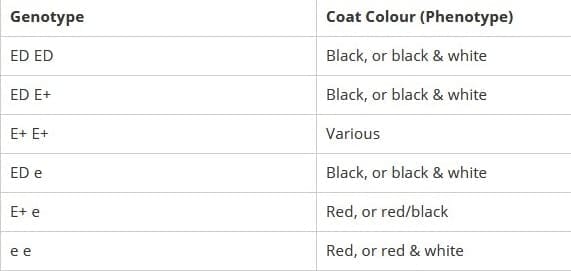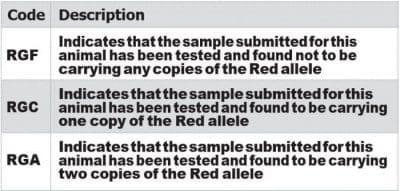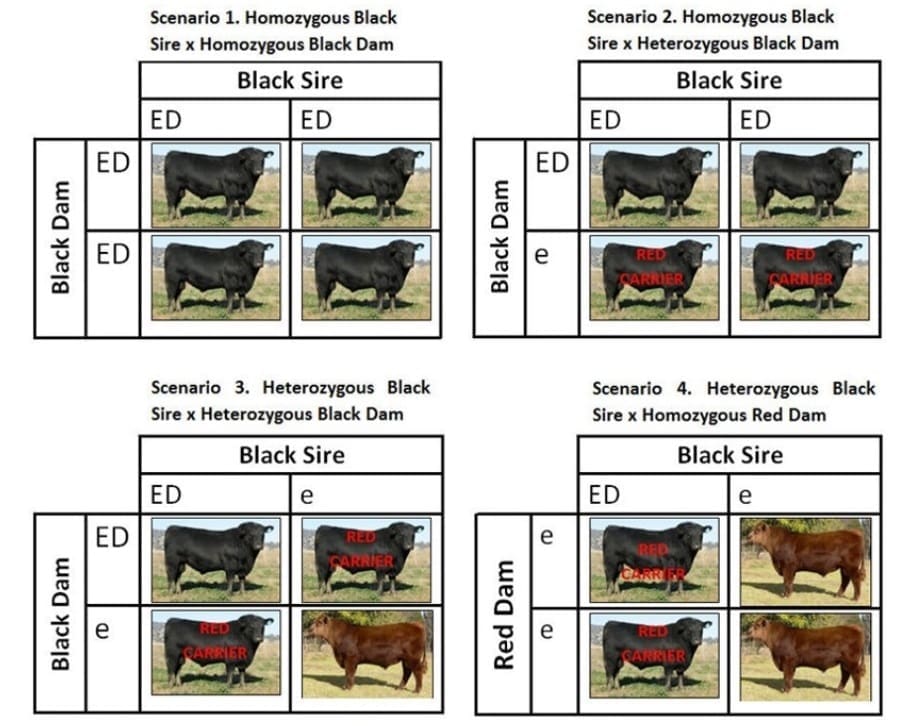COAT colour is an easily recognisable trait and for many breeds a defining characteristic, so much so that many breeders include coat colour as an important part of their animal selection criteria.
Coat colour shows a clear distinction between phenotypes and is a qualitative trait, controlled by only a few genes.
While a few different genes influence coat colour, all animals have one base coat colour, being either black or red. Other colours such as Spotting, Dilution, Roan and Brindle are caused by other genes acting on this base coat colour.
The genetics of coat colour
A gene called the melanocartin 1 receptor is involved in the production of red/black coat colour in cattle. The melanocartin 1 receptor controls the levels of an enzyme called tyrosinase in skin cells. High levels of tyrosinase in the skin cells cause a dark colour (brown or black) while low levels of tyrosinase result in a light coat colour (red or yellow).
The two main alleles (or alternative forms) for the melanocartin 1 receptor gene are Black (ED) or, Red (e), while another allele, Wild Type (E+) is also present in a very small percentage of animals, including Angus cattle.
Each animal inherits two alleles for coat colour, one from each parent, with the Black allele being dominant over both the Red and Wild Type alleles. An animal can consequently be phenotypically, or visually Black but still carry one copy of either the Red or Wild Type allele, which can then be inherited and expressed by progeny. The Wild Type allele (E+) is considered to be neutral and can produce either a red or black coat colour depending on its interaction with other genes. The Red allele (e) is recessive and an animal must carry two copies of the Red allele to have red coat colour.
All the possible genotypes and their corresponding phenotypic expressions of coat colour are shown below.

Table 1. Possible genotypes for coat colour and corresponding phenotypes
Breeding for coat colour – the theory
Because animals inherit two alleles for the base coat colour, it is possible that their phenotype, or visual appearance, does not reflect their underlying genotype. For example a phenotypically black animal may be either “homozygous” Black, meaning they have two copies of the Black allele (ie. ED ED), or “heterozygous” Black, meaning they have one copy of the Black allele and one copy of either the red or wild type allele (i.e. ED e or ED E+).
Consider the four mating combinations shown in Figure 1 where only phenotypically black sires are used in a breeding program.
In the first scenario, homozygous black dams (ED ED) are joined to a homozygous black sire (ED ED) with 100pc of the resulting offspring being homozygous black (ED ED).
In the second scenario, heterozygous black dams carrying the Red allele (ED e), are joined to a homozygous black sire (ED ED). The resulting offspring will all be phenotypically black, but 50pc will be heterozygous (ED e) and will carry one copy of the Red allele.
In the third scenario, heterozygous dams (ED e) are joined to a heterozygous sire (ED e), with 25% of the resulting offspring being homozygous black (ED ED), 50pc being heterozygous black (ED e) and 25pc being homozygous red (e e).
In the final scenario, homozygous red dams are joined to a heterozygous black sire. The resulting offspring will be 50pc heterozygous black carriers and carrying one copy of the Red allele, while the remaining 50% would be homozygous red.
The above scenarios not only apply to straight-bred Angus breeding programs, but also to crossbreeding programs where Angus animals may be joined to animals from another breed. For example, if a heterozygous Black Angus sire is joined to Hereford cows, who are homozygous red, 50pc of progeny would be black Baldies, while 50pc would be red Baldies, as per the final scenario.
DNA tests for coat colour
A number of DNA tests are available that enable breeders to determine whether a phenotypically black animal is carrying one copy of the Red allele, and therefore has the potential to produce a proportion of phenotypically red offspring if joined to other animals who also possess a Red allele.
Figure 1. Four mating combinations where phenotypically black sires are used in a breeding program.
DNA testing can be carried out as part of Angus Australia’s DNA services as either a stand-alone test, as an individual add-on to the HD50K for Angus or Angus GS genomic products, or as part of the full genetic test add-on panel to the HD50K for Angus or Angus GS genomic products.
Testing as a stand-alone test is available for $25.85 via both Zoetis and Neogen, whereas the cost if conducted as an individual add-on to HD50K for Angus or Angus GS is $8.25 or $11.00 respectively. The full genetic test add-on panel to both HD50K for Angus GS is available for $41.25 and includes all 8 genetic conditions recognised by Angus Australia, plus coat colour, myostatin and homozygous poll.
DNA test results for animals which have been tested for the Red allele are displayed on the “Genetic Tests” tab within the Angus Database Search and Angus SELECT facilities on the Angus Australia website. A list of the genetic test codes displayed are shown in Table 2.
In addition, a suffix of (RED) is displayed at the end of the name for any animals recorded with Angus Australia that are red in colour.
Breeding for coat colour – the practical
While the majority of Black Angus animals are homozygous black, a proportion are heterozygous black, and if joined to other heterozygous black or homozygous red animals, can produce a proportion of calves that are red in colour.
Breeders wishing to minimise the incidence of calves that are red in colour should carefully consider and develop a management strategy that is suitable for their breeding program. This is particularly important in herds where there is a higher likelihood of breeding females carrying the Red allele, such as in straight-bred Angus herds that have a history of producing the occasional red animal, or commercial herds that have other breed content in their background, such as Hereford or Shorthorn.
In simple terms, animals that are red in colour can be prevented by avoiding mating a Red allele carrier sire to a Red allele carrier dam.
Only using sires that have been found not to be carrying the Red allele via DNA testing, or sires who are not expected to be carrying the Red allele from analysis of their pedigree, is sufficient in most circumstances.
Breeding for coat colour should always be balanced with selection for other traits of economic and functional importance within the breeding objective. Simply selecting for coat colour without consideration for other economically important traits may potentially compromise the genetics of animals for these other traits.

Table 2. Genetic test codes within the Angus Database Search and Angus SELECT facilities
Source: Angus Australia


question: If a Hereford tests for E+e, does this mean the animal is not pure Hereford and another breed (like red Holstein) has been bred into the herd, probably to increase frame size.
I want to know more colour about cattle
Black color is dominant to red in cattle and brown face color is dominant to no brown color face.. if we cross the angus beef and hereford beef, what are the genetic probabilities of the offspring at the second generation.
With a homozygous black bull throwns red calves that turn black at 3 months old. What would this mean?
They aren’t red, its just the baby hair, they are genetically black as you can see by their nose pigment etc.
1) Roan cattle, like the one shown below, have mottled red and white coats that consist of areas where only red hair is produced and areas where only white hair is produced. A series of crosses were made between red, white and roan cattle, with the following results:
a) Propose a genetic hypothesis to account for these results, writing the genotypes of all progeny in the spaces provided in the table above.
A true ‘roan’ can have both red and white hairs intermingled in the same space – often interspersed with ‘patches’ of red-only, and white-only hairs. Editor.
What will be the genotips and fenotips of the offspring if a black and white coated bull and black and white coated cow crossover?
This is a great introduction to alleles and Mendelian inheritance. It helped me a lot – thanks